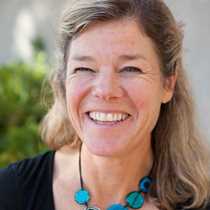Santa Cruz Island
Today we visited the island of Santa Cruz, the most populated island in the archipelago, hosting a year-round population of approximately 20,000. While many of us toured the Charles Darwin Station and learned about the station’s vital research and conservation work, Dr. Tierney Thys, our National Geographic Expert, visited the local Tomas de Berlanga school to share her research on the giant ocean sunfish, Mola mola, with the students. The students were filled with questions and excited to learn about this state-of-the-art technology that provides scientists near real-time locations from the tagged fish.
The week before this expedition began, Dr. Thys and her colleagues from the Charles Darwin Station, UC Davis and the University of Hawaii, were at Isabela Island in the northwest part of the archipelago. She and her team were placing GPS satellite tags and acoustic tags on giant ocean sunfish, deploying ultrasonic listening stations and collecting genetic samples. This exciting research is funded by the National Geographic Society and made possible through its partnership with Lindblad Expeditions.
Later in the day, some active souls took a mountain bike ride, while the rest of the group drove, up to an amazing sugar cane mill and small coffee plantation located in the highlands of the island. Here we learned about sugar extraction, coffee cultivation and how to make extremely strong alcohol from fermented cane juice.
After a sumptuous lunch, we explored another region of the highlands where we communed with enormous wild tortoises, listening to their crunching and munching and occasional prehistoric hissing.
Returning to Puerto Ayora, we gathered a few souvenirs from this bustling town before taking the Zodiacs back to the ship to enjoy a presentation from a representative of the Charles Darwin Research Station, a delicious dinner and the music and dancing of the local group EcoArt. The dancing and merrymaking went well into the evening. Another fun-filled, amazing day in these enchanted islands.




